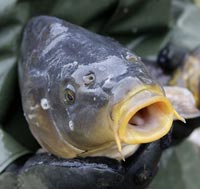 Last week, a paddler in a kayak race on the Missouri River was hit on the side of his face by a 20-30 pound jumping carp, almost causing him to capsize. Fortunately he was not seriously injured but had to retire from the race due to a significant headache.
Last week, a paddler in a kayak race on the Missouri River was hit on the side of his face by a 20-30 pound jumping carp, almost causing him to capsize. Fortunately he was not seriously injured but had to retire from the race due to a significant headache.
Asian big head and silver carp were first brought to the southern United States back in the 1970s to clean catfish farms, and they have made their way north through the Mississippi River basin spreading to the Missouri River and the Wabash Rivers, also invading Canadian waters, particularly the Great Lakes. Not only are they a threat to native fish, but have proven to be dangerous to recreational boater. Silver carp, in particular, are notorious for jumping when excited.
Flying carp hits racing kayaker in the head
Brad Pennington initially thought someone had thrown a brick at him from the shores of the Missouri River. It turns out it was a flying silver carp.
Pennington was near mile 35 of the Missouri River 340 boat race about 11 a.m. Tuesday when the airborne fish hit him in the side of the face and nearly caused him to capsize his kayak.
“My first thought was ‘What hit me?’” Pennington said. “The second thing was that I couldn’t believe I didn’t capsize with a boat like I had.”
Pennington, 43, an accomplished river racer from Houston, was paddling an Olympic-style kayak that measured 17-feet long and just 12-inches wide at its widest point. With the river’s depth approaching its extreme for this time of the year, a spill into the water could have meant legitimate danger for Pennington.
“I could have been swimming for miles,” he said. “I’m relieved to get hit by something like that and stay upright.”
Silver carp, which are not indigenous to North America, have become a genuine problem in the Missouri River, injuring fishermen, water skiers and other recreational boaters. Another species of Asian carps, the bighead carp, is affecting the health of native fish according to Duane Chapman of the Columbia Environmental Research Center.
The species was originally brought to this county from Asia in the 1970s in an attempt to control algae and plankton in aquaculture (fish farming) and sewage treatment. The theory was that these carp would eat excess amounts algae and plankton, lowering the amount of harmful elements like nitrogen and phosphorus in the water. The plan failed, but along the way, some bighead carp escaped the lagoons and aquaculture areas, spreading into streams and spawning.

My grandmother, who immigrated from Russia in 1906, said she remembered carp as a food fish in Europe and also that on at least one occasion in the 1920’s she bought fresh carp from sport fishermen who were only interested in catching them, not considering them edible. If Old World carp only came here in 1970, what did she mean? Is there a European carp different from the Asian variety, or a native US fish that resembles what you could find in Europe? She came from Western Russia, near today’s Polish border.
I know nothing about carp, but from Wikipedia, the European carp is a sub-species of the common carp which was brought to the United States in 1831.
Apparently carp is native in Europe and spread to most of the world.
Asian Carp Recipe
•Fillet and skin fish (this will take a couple of hours as the fish has enough bones for several fish.)
•Soak fillets in milk for 24 hours.
•Roll fillets in flour and seasonings of your choice.
•Dice up onions and slice potatoes.
•In large cast iron fryer,fry fish and vegetables until fish and potatoes are golden brown.
•Throw away fish and eat cast iron pan.
(source: internet, daYooper)
Thanks Christina,
Always good to have a diet rich in iron.
Pingback: OMG! Invasive Species: Asian Carp Confound U.S. System – Nick's Crusade